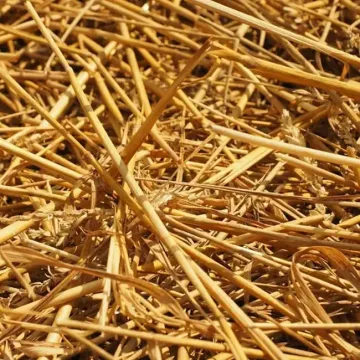Hay vs. Straw: The Basics
Hay is made up of cut and dried grasses or legumes (like alfalfa or clover). It contains leaves, stems, and seeds. Since hay is grown primarily as livestock feed, it is harvested before the plants go to seed to retain maximum nutritional content. This makes hay a rich, nutrient-dense mulch that breaks down into a beneficial soil amendment. However, it can contain weed seeds, which may sprout in your garden if used as mulch.
Straw, however, is the stalk that remains after grains like wheat, barley, or oats are harvested. It consists mainly of hollow, dried stems and is generally free of seeds since the grain heads are removed during harvesting. Straw is less nutrient-rich than hay, but it is often used as mulch because it is lighter, less likely to compact, and usually contains fewer seeds that might germinate in the garden.
Straw as Mulch
While straw is generally considered to be relatively seed-free, this is only sometimes the case. In some instances, stray grain seeds may remain in the straw, which can lead to unwanted growth in your garden beds. This often occurs if the straw needs to be thoroughly cleaned or processed before being baled. If these seeds sprout, you may have a weed problem, especially with grains like wheat or oats taking root among your garden plants. There are fewer seeds in straw vs hay, so it is a safer bet when selecting a mulch.
To avoid this issue, it is a good practice to look for "seed-free" or "cleaned" straw from reputable suppliers. Some gardeners also prefer to use straw that has been heat-treated or composted, as this can help destroy any remaining seeds and reduce the risk of unwanted plants.
Hay as Mulch: The Seed Issue
Unlike straw, hay almost always contains seeds since it is cut before the plants have matured and seeded. This can include not only grass or legume seeds but also weed seeds that were present in the field. Using hay as mulch can unintentionally spread these seeds, leading to more weeds and competition for resources with your desired garden plants.
Despite these downsides, hay can be an excellent mulch if you can source "weed-free" or "seedless" hay, which is harvested and processed in a way that minimizes the seed content. Some gardeners also prefer to compost hay first to kill off any seeds before using it as mulch.
Herbicide Contamination: A Growing Concern
Whether you choose hay or straw, it's crucial to know the source of your material. Some hay and straw come from fields treated with herbicides to control broadleaf weeds. These chemicals, particularly persistent herbicides like clopyralid and aminopyralid, can remain active in the straw or hay for several years, potentially causing harm to your garden plants. If contaminated mulch is used, it can result in stunted growth, curled leaves, and other symptoms of herbicide damage.
Tips to Avoid Herbicide Contamination:
- Ask the Supplier: When purchasing hay or straw, ask the supplier about the source and whether herbicides were used in its production. Look for materials labeled as "organic" or "untreated."
- Perform a Bioassay Test: If you need clarification on the safety of your hay or straw, perform a simple bioassay test. Mix some of the material with water, let it sit, and then use this water to grow a small batch of sensitive plants like beans, peas, or tomatoes. If they show signs of damage, avoid using the hay or straw in your garden.
- Composting: Composting straw or hay can help break down potential herbicides. However, this requires maintaining high temperatures (above 140°F) for an extended period to ensure the breakdown of harmful chemicals.

